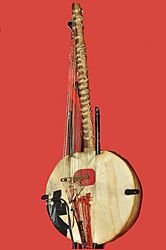Kora (instrument) facts for kids
 |
|
| String instrument | |
|---|---|
| Classification | West African stringed instrument with 21 strings |
| Hornbostel–Sachs classification | 323-5 (Composite chordophone sounded by the bare fingers) |
| Developed | 16th century |
The kora is a special 21-string harp-lute instrument. It is mostly played by people in West Africa. It's a key instrument for the Mandinka people. The kora is built from a small calabash (a type of gourd) cut in half. This half-gourd is covered with cow skin. This creates a sound box, called a resonator. The kora also has a long neck made of hardwood. Two handles run under the skin to support it. Each of its 21 strings plays a different musical note.
How the Kora is Played
Traditional koras usually have 21 strings. Players use their left hand to play eleven of these strings. Their right hand plays the other ten strings. Some modern koras are made in the Casamance region of southern Senegal. These might have extra bass strings. This means they can have up to four more strings than the traditional 21.
Kora Strings and Sound
In the past, kora strings were made from thin strips of animal hide. For example, antelope skin was often used. Today, most kora strings are made from materials like harp strings or nylon fishing line. Sometimes, these nylon lines are braided together. This makes thicker strings for a richer sound.
An important part of old koras was the nyenmyemo. This was a leaf-shaped piece of tin or brass. It had wire loops around its edge. When attached to the bridge, it made extra sounds. This helped to make the kora louder, especially outdoors. Today, kora players often use an electric pickup. This helps to make the sound louder, especially when playing in bigger spaces.
Images for kids
-
Kora (Bridge-Harp Or Plucked Harp-Lute) from St. Cecilia's Hall Museum, Edinburgh
-
Master kora-maker Alieu Suso of the Gambia
-
A kora player wearing a korte necklace, from the central northern Bandiagara Escarpment, Mopti Region, Mali. The kora neck and handles appear to have broken off. Late 1700s.
-
Sambou, jali of Niantanso, Mali, with a Kamalengoni (a relation to the Kora) in 1872.
-
Kora players in Sénégal, 1900. The koras are straight-necked, with handles, carrying cords, tacked skins and small, square soundholes.
-
Jali Fily Sissokho playing a 22-string kora, tuned with konso string terminations and strung with nylon monofilament strings, 2008.
-
The gravi-kora, an electric instrument, lacks the acoustic instrument's gourd-and-skin resonator.
See also
 In Spanish: Kora (instrumento) para niños
In Spanish: Kora (instrumento) para niños












